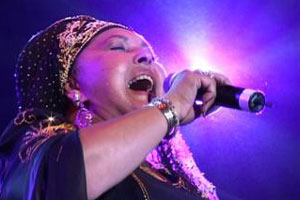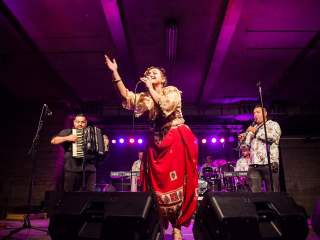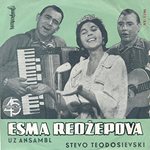FolkWorld #72 07/2020
Esma Redžepova: Gipsy Dance
Esma Redžepova-Teodosievska (Macedonian: Есма Реџепова-Теодосиевска; Macedonian pronunciation: [ˈɛsma rɛˈd͡ʒɛpɔva tɛɔdɔˈsiɛfska]; 8 August 1943 – 11 December 2016) was a Macedonian vocalist, songwriter, and humanitarian of Romani ethnicity. Because of her prolific repertoire, which includes hundreds of songs, and because of her contribution to Roma culture and its promotion, she was nicknamed Queen of the Gypsies.
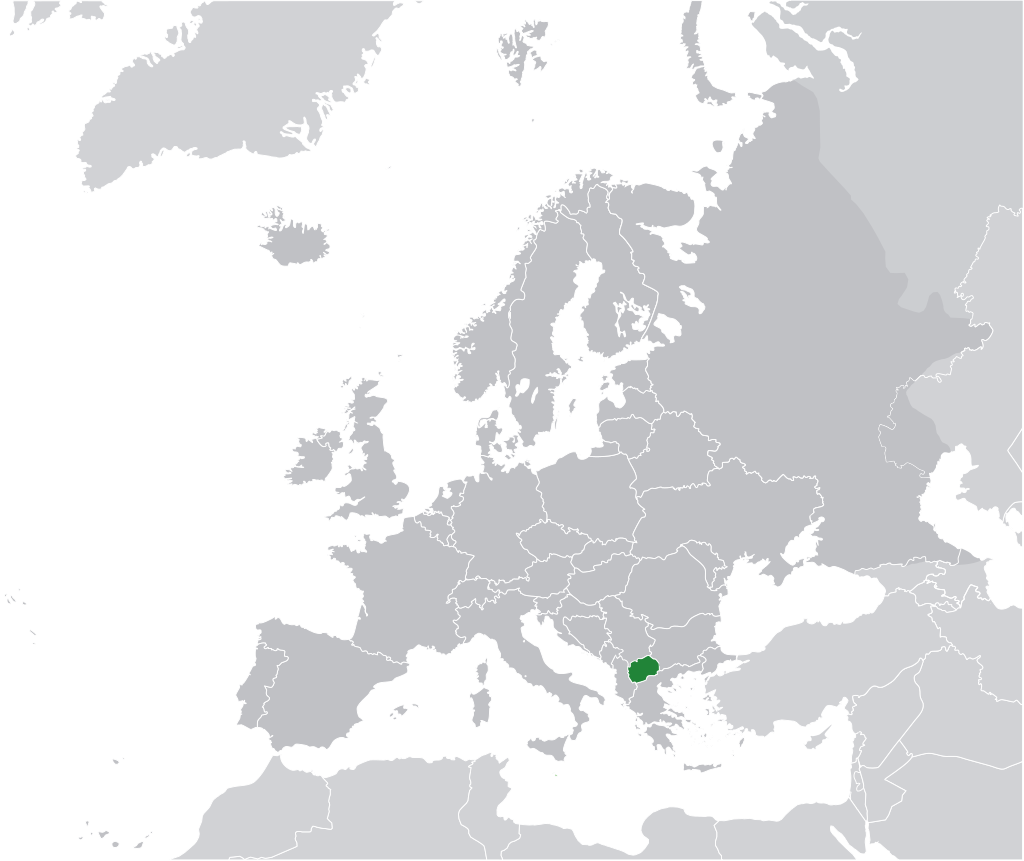
 The ethnic Macedonian traditional music, which can be rural or urban (starogradska muzika), includes: lyric songs, epic songs, labour songs, ritual songs, humorous songs, circle dance ("oro"), the old urban style called Čalgija (not to be confused with chalga) etc.
Popular traditional songs are: Kaleš bre Angjo, Slušam kaj šumat šumite, Biljana platno beleše, Dafino vino crveno, Narode Makedonski, Zemjo Makedonska and many others.
Often referenced oro dances are Teškoto from the village of Galičnik, Kalajdžiskoto, Komitskoto (The Dance of the freedom fighters) and others. An internationally acclaimed professional folklore association is the award-winning Tanec.
The ethnic Macedonian traditional music, which can be rural or urban (starogradska muzika), includes: lyric songs, epic songs, labour songs, ritual songs, humorous songs, circle dance ("oro"), the old urban style called Čalgija (not to be confused with chalga) etc.
Popular traditional songs are: Kaleš bre Angjo, Slušam kaj šumat šumite, Biljana platno beleše, Dafino vino crveno, Narode Makedonski, Zemjo Makedonska and many others.
Often referenced oro dances are Teškoto from the village of Galičnik, Kalajdžiskoto, Komitskoto (The Dance of the freedom fighters) and others. An internationally acclaimed professional folklore association is the award-winning Tanec.
The music of the Balkans is known for complex rhythms. Macedonian music exemplifies this trait. Folk songs like "Pomnish li, libe Todoro" (Помниш ли, либе Тодоро) can have rhythms as complex as 22/16, divided by stanza to 2+2+3+2+2+3+2+2+2+2, a combination of the two common meters 11=2+2+3+2+2 and 11=3+2+2+2+2 (sheet music). In order to add tension to notes, musicians (primarily from older schools) will add the distinctive characteristic of stretching out beats.
The gajda (гајда), a type of bagpipe, was the most common folk instrument in traditional Macedonian culture. It has now become an instrument for concert recitation, drawing on recent legends like Pece Atanasovski (video), leader of the Radio Skopje ensemble Ansambl na Narodni Instrumenti, as the source of modern tradition.
Macedonian folk orchestras consist of a clarinet or saxophone, drum kit, bass guitar, accordion and guitar, sometimes with modern synthesizers and drum machines. These orchestras are very popular in Macedonia. Popular members are virtuoso musicians Skender Ameti and Goran Alachki on accordion and Miroslav Businovski on clarinet.
Čalgija is an urban style, played by bands (Čalgii) with a dajre (tambourine) and tarabuka (hourglass drum) providing percussion for ut (lute), kanun (zither), clarinet and violin. Though modern musicians have updated the Čalgija into a spectrum of hard and soft, classical and pop sounds, some traditional musicians remain. Perhaps the most influential of recent years was Tale Ognenovski, who plays a wide variety of traditional and modern sounds.
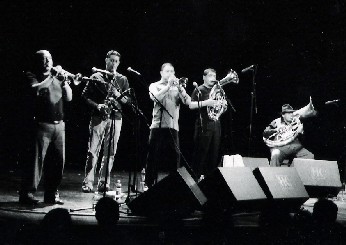
After World War II People's Republic of Macedonia sponsored the creation of professional ensembles such a "Chalgii orchestra", "Folk music orchestra" and "Authentic folk instruments orchestra" which were departments of "Radio Television Skopje" and performed arranged version of folk melodies. Folk music orchestras performed arranged versions of folk melodies.
At the International Folklore Conference organized by the International Folklore Committee in Istanbul, Turkey, 1977, on the subject of "Folklore on the Radio" representative from Yugoslavian Radio Television (Former Yugoslavia) was Dushko Dimitrovski, Editor of the Folk Music Department for "Radio Television Skopje" (now Macedonian Radio Television) from the Socialist Republic of Macedonia presented folklore material in his presentation entitled "Chalgija music in Macedonia", including the recordings of Macedonian folk dances: "Kasapsko oro", arranged by Tale Ognenovski, and "Kumovo oro chochek", composed by Tale Ognenovski and performed by him as clarinet soloist accompanied by the "Chalgii" orchestra of Radio Television Skopje (now Macedonian Radio Television), which created great interest not only amongst the delegates of the Conference but also around the world.
In the book entitled "Rough Guide to World Music Volume One: Africa, Europe & The Middle East" written by Simon Broughton and Mark Ellingham on page 202 subtitle: Macedonia tricky rhythm, Kim Burton noted: "In western music, a bar of triple time – such as a waltz has three equal beats: but in Macedonia it may a bar of 7/8 divided up as 3-2-2 or 2-2-3 or 2-3-2 and so on…" In this book on page 203 was written: "One of the few clarinettists to have performed successfully both with a calgia and in the more modern style is Tale Ognenovski, born in 1922 and one of the most influential musicians of the post-war era. He was a member of the Tanec group during the 1950s and lead clarinet of the Radio Skopje calgia. The composer of many tunes that have become standards, and which is the basis for Macedonia's own new composed folk music."
The magazine "Ilustrovana politika" observes,"Radio Television Belgrade” (PGP-RTB, now PGP-RTS Radio Television of Serbia, Serbia) released a LP of Macedonian folk music (LP 1439 RTB, produced in 1979), on which is performances by the extraordinary clarinetist Tale Ognenovski. His music repertoire is folk dances, jazz (besides others he includes works by Benny Goodman and Artie Shaw), concerts from Carl Maria von Weber, Mozart and Ernesto Cavallini...This is Tale Ognenovski who began to play the clarinet in the village of Brusnik near Bitola, who with this wooden instrument toured the world and received well-deserved applause wherever he performed."
In his book, For Our Music Dushko Dimitrovski writes: "The impossible becomes possible: two usually non-complementary parallel-existing worlds of sounds, Europe and The Orient, are in Tale Ognenovski's music naturally brought closer together, understand each other and merge."
In September, 2001 Tale Ognenovski released CD album: Jazz, Macedonian Folk Dances and Classical Music Reviewer Neil Horner of the MusicWeb International comments, "He is undoubtedly an exceptional artist and the predominant image created in my mind is of Benny Goodman playing the superb Contrasts he commissioned Bartók to write for him …This disc is likely to appeal to world music aficionados who enjoy the Balkan/Levantine soundworld and perhaps also those who care to hear the source musics of their classical favourites, the aforementioned Bartók but also, here, perhaps people like Skalkottas."

Contemporary folk music is a popular style based on the traditional folk music. However, unlike it, contemporary folk music is credited to a particular author and it falls under the copyright laws, it is performed by professional musicians and it is usually (but not necessarily) played with modern instrumentation. Usually, the older performers and composers (such as the highly acclaimed Aleksandar Sarievski, Jonče Hristovski and Dobri Stavrevski) stay closer to the traditional roots, and thus contemporary folk music is often mistaken for traditional. On the other hand, the younger usually espouse a more modernized sound and image, thus often being disproved by the traditional purists as kitsch. Nevertheless, the style is popular among the common people and notable performers include: Elena Georgieva, Suzana Spasovska, Mitre Mitrevski, Efto Pupinovski, Vojo Stojanovski, Orce Stefkovski, Blagica Pavlovska, Dragan Vučić, Zoran Vanev, Vaska Ilieva and others. Some of them also perform traditional songs. The newest generation of performers of this genre such as Aneta Micevska, Blagojce Stojanovski-TUSE, Sonja Tarculovska, Elena Velevska, Jasmina Mukaetova, Aneta Nakovska, Pane Panev altogether with the bands such as Molika, Bioritam, Bolero bend, Art Plaza have introduced a newer outlook to this kind of music inspired by the Serbian turbofolk, Bulgarian chalga, and Greek laika, so their style is more considered as pop-folk, rather than folk music.
Several popular folk music festivals exist, including: Folk fest Valandovo in Valandovo, Serenada na Širok sokak in Bitola, Cvetnici in Skopje, Ohridski trubaduri – Ohrid Fest in Ohrid and others.

She started to sing while she was a teenager in the 1950s, and her career spans over five decades. Her musical success was closely linked to her marriage with Stevo Teodosievski, who was a composer, arranger and director of a musical ensemble, the Ansambl Teodosievski. He wrote many of her songs and fully managed her career until his death in 1997. Her musical style was mostly inspired by traditional Roma and Macedonian music. Some other influences are also noticeable, such as pop music. Esma Redžepova started her career at a period when Romani music was very denigrated in Yugoslavia and Roma people considered it shameful for women to sing in public. Redžepova was one of the first singers to sing in Romani language on radio and television.
Redžepova was particularly noted for her powerful and emotional voice. In 2010, she was cited among the 50 great voices in the world by NPR, a prominent American media organization. Redžepova was also noted for her extravagant attires and her turbans, as well as the use she made of typical stereotypes about Roma women, such as sensuality and happiness. In 2010, she was awarded the Macedonian Order of Merit and in 2013 entitled National Artist of the Republic of Macedonia by Macedonian President Gjorgje Ivanov.

While all band members were among Esma’s nearest and dearest, lead vocalist Eleonora Mustafovska has a couple of truly unique distinctions:
she was the only girl adopted by Esma, as well as being the only female vocalist trained by her. Esma and her husband Stevo Teodosievski
gave homes to forty-seven foster children throughout their married life, and adopted five of them, including Eleonora. She continues where
Esma left off; seeking to promote Esma’s style and to keep her songs alive.
Track Listing:
Gipsy Dance |
Kaj Sijan |
Khelen Giljaven |
Ljubovta e Raj |
Ma Hovav Man |
Rodena za Pesna |
Romano Ilo |
Samo Tute |
Zaedno |
Chochek
Esma’s Band – Next Generation "Gipsy Dance", ARC Music, 2020
With her late husband Stevo Teodosievski she fostered 47 children and received numerous accolades for her humanitarian work. She supported Roma and women rights and was also involved in local politics in her hometown, Skopje.
Redžepova, together with Vlatko Lozanoski, represented Macedonia in the Eurovision Song Contest 2013 in Malmö, Sweden.
She died on 11 December 2016 after a short illness.
Early life and background
Redžepova was born on 8 August 1943 in Skopje, at that time annexed by the Kingdom of Bulgaria, although the region was returned to Yugoslavia in 1944. She was the second youngest of six children in a Romani family. Her paternal grandfather was a Catholic Roma and her grandmother an Iraqi Jew, while her mother was a Muslim Roma from Šuto Orizari.
Her father Ibrahim, who had lost a leg during a German bombing in Skopje in 1941, worked variously as a porter, circus strongman and shoeshiner. He sang and played drums and sometimes performed at weddings. Some of Esma's siblings accompanied him. Esma's mother was a seamstress.
At age nine, Esma was introduced by one of her brothers to a local Romani music organisation where she was able to quickly learn complicated rhythms. Her mother encouraged her musical gifts and Esma and her brother soon joined their school's folklore group. Her parents insisted that all their children finish primary school. However, they had very traditional views and expected Esma to get married in her teens and become a housewife. Nonetheless, their daughter was emancipated and would wear fashionable dresses instead of dimije, the traditional attire for Romani girls at that time.
Music career
Debut
In 1956, Esma's headteacher suggested she sing at a school talent contest for Radio Skopje. She went without informing her parents, who did not want her following the path of her older sister who started singing in cafes at age 17. Among Roma people, such a career was viewed as inappropriate or shameful for an unmarried girl.
Esma performed A bre babi, a Macedonian Roma traditional song. It was the first time a song in Romani was aired by the station. Esma won the contest, beating 57 other schools and winning 9,000 dinars. When Esma's parents learned about her success, they were upset and reluctant to let her follow a musical career. At that time, the only employment prospects for Roma singers were performing in cafes and restaurants.
Stevo Teodosievski, an ethnic Macedonian musician and band frontman, was impressed by Esma's performance at the contest and hoped she might join his musical ensemble. Teodosievski was a self-taught man coming from a poor background, leading the large folk musical troupe Ansambl Teodosievski. He also worked for Radio Skopje and was a member of the League of Communists of Macedonia.
As part of the local establishment, Teodosievski was somewhat of a visionary in holding the belief that Roma music could one day become esteemed and popular among non-Romani people. At that time, Roma music in Yugoslavia was disparaged and not considered suitable for radio or television. Furthermore, racism against Roma people was common in Macedonia and throughout Yugoslavia, and even Roma people themselves had a low opinion of Roma singers — especially female ones. Before Esma, Roma performers never sang in Romani on radio or television and hid their origins. Teodosievski had been promoting Roma music even before meeting Redžepova and faced harsh criticism in the media for it. However, he felt Esma could help him achieve his goals and perhaps even become one of the most prominent artists in the country. He convinced Esma's parents to let her go with him and join his ensemble. It was promised that Esma would only sing in reputable circumstances.
When they met in Skopje, Stevo Teodosievski was not fully satisfied with Esma's voice. He encouraged her to train for long hours and enroll at the Academy of Music in Belgrade, where she studied for two years.
Yugoslav years
After Esma left the Academy of Music in Belgrade (SR Serbia), she joined the Ansambl Teodosievski and started touring. In 1961, the Ansambl went to Zagreb (SR Croatia) to record Redžepova's first disc. It was released by Jugoton and included A bre babi as well as Chaje Shukarije, a song Redžepova wrote herself. This song in Romani quickly became a huge success in Yugoslavia.
The 1960s and 1970s were extremely successful for the couple. They recorded many albums and EPs, and took part to radio and television shows. Most of the songs performed by Esma Redžepova at that time were traditional Romani songs or songs inspired by Romani music. However, some of them had a noticeable Western influence. "Makedo" is inspired by cha-cha, "Kod Kodak" shows heavy pop influences, and "Pesma Šeher Sarajevu", makes use of psychedelic organs. Redžepova also performed many songs related to ethnic Macedonian music with no tie to Romani music. Some of these songs are duets recorded with Macedonian singers, such as "Blagujno Dejče", "Biljana platno beleše" and "Zašto si me majko rodila".
In Tito's Yugoslavia, Roma people were officially recognised as a national minority and were granted linguistic and cultural rights. However, Esma Redžepova was almost the only Roma Yugoslav artist to have achieved long-lasting fame and public acclaim, together with Šaban Bajramović, from Serbia.
Despite of her success, Esma Redžepova was the target of racism and gossip. Roma people in Skopje thought of her as dishonorable for the community and were very critical about her relationship with Teodosievski, a "gadjo". At that time, it was unthinkable for Macedonians and Romani to engage in mixed marriages, and both communities strongly disapproved them. Esma was frowned upon by Romani because she had an emancipated lifestyle, performing on stage, sleeping in hotels, working with men. On the other side, institutions, including Radio Skopje and the League of Communists of Macedonia, where very critical about Stevo Teodosievski and reproached him for working with Gypsies. To escape the stifling atmosphere, Redžepova and Teodosievski moved to Belgrade, the capital of Yugoslavia, at the beginning of the 1960s. They married in 1968.
Racist prejudice played a big part in Redžepova's career. Media often characterized her with traits considered typical to Roma people: she was portrayed as hot blooded, happy and easy going, and genetically talented. Comments were often made about her dark skin. Stevo Teodosievski used some positive stereotypes to promote the singer, as long as they gave a tasteful image of her.
At the end of the 1960s, Esma and Stevo founded a music school where they mostly trained young disadvantaged boys, usually Romani. Most of the musicians in the Ansambl Teodosievski were trained in the school and some of them eventually achieved fame. In total, 48 boys attended that school.
By encouraging other Macedonian Roma musicians, Esma and Stevo built a circle around them. Among the most prominent members were the singers Muharem Serbezovski, Usnija Jašarova and Enver Rasimov, and clarinetist Medo Čun.
Yugoslavia was part of the Non-Aligned Movement and the Yugoslav artistic scene was subject to many international influences. Esma performed several songs in foreign languages, such as Greek, Turkish, Hebrew or Hindi. The Roma people came from India to Europe in the Middle Ages. The link that Tito created with Nehru and India was very important for Yugoslav Gypsies because their culture and history was publicly enhanced. Esma and Stevo visited India three times, in 1969, 1976 and 1983. During their second trip, they were entitled King and Queen of Romani Music at the first Roma music festival in Chandigarh. In 1983, Esma sang in front of Indira Gandhi.
In addition to performing for Indira Gandhi, Esma also sang for Josip Broz Tito, Reza Pahlavi and Muammar Gaddafi. Together with her husband's ensemble, she performed for public audience in several countries, including the United States, the Soviet Union, Mexico, Australia and Canada. In 1962, she was the first Yugoslav artist to perform at the Olympia in Paris.
Career after the independence of Macedonia
During the 1980s, the musical career of Esma Redžepova slowed down. In 1989, she settled back in Skopje with her husband. After independence in 1991, the Republic of Macedonia went through difficult times. Stevo Teodosievski died in 1997 at 72. However, Esma Redžepova toured the United States the year after, performing at a series of benefit concerts. She also released a selection of duets with Usnija Jašarova in 1994.
The 2000s where very fruitful and marked a slight shift in the singer's career. In Macedonia and former Yugoslavia, Esma gained a more modern image and redefined herself as a worldbeat artist. For instance, she made several collaborations with young pop singers. In 2002, she recorded a song with the Croatian band Magazin and a duet with the Macedonian singer Todor Proeski. She also recorded a song with the Bosnian band Crno Vino in 2005 and made a collaboration with Kiril Džajkovski in 2010. On the international scene, Esma Redžepova contributed towards the establishment of Roma music as a non-mass-market good, pleasing an urban and cultural elite. However, many of her new songs were not widely accepted by Western audience because they did not match its expectation about Roma music. For instance, some songs featured synthesizer, an instrument that is not used in traditional Roma music. Esma was even booed at a concert in Spain, but defended herself saying that Roma music has always adapted itself and borrowed external features.
Her best known single, Čaje Šukarije, is the feature song on the 2006 Borat movie soundtrack, which she claims was used without her permission. Together with Naat Veliov from Kočani Orkestar she sued the producers of the film for 800,000 euro (USD 1,000,000). Afterwards, Redžepova won a €26,000 compensation, since it turned out that Sacha Baron Cohen got permission from her production house to take the song, which she was not notified about. Esma was particularly upset because her song was used to illustrate backwardness, something she always fought. However, Borat contributed towards the expansion of her fame internationally.
Esma Redžepova was selected together with Vlatko Lozanoski to represent Macedonia in the Eurovision Song Contest 2013. Their song, "Imperija", was unveiled in March 2013, but it caused controversy in the country as its clip featured many monuments of the controversial project Skopje 2014. The song was thus viewed as a nationalist act. Macedonian Radio-Television requested the singers write a new song. Eventually, "Pred da se razdeni" was released a month later. The song failed to advance from the second semi-final of the competition on 16 May 2013, placing 16th in the field of 17 songs, scoring 28 points.
Death
Esma Redžepova died on the morning of 11 December 2016 in Skopje after an illness, she was 73. She had previously been taken to hospital on 28 November, and was then in a critical condition. Her funeral ceremony took place on 12 December at the Skopje City Council, where several officials, including the Mayor of the city and the Macedonian President, Gjorge Ivanov, paid homage to her. She was later buried at Butel cemetery.
Film career
In addition to numerous video clips, Esma Redžepova appeared in several films, both fictional and documentary. She made her debut as an actress in Krst Rakoc, a Yugoslav film released in 1962 and featuring Bata Živojinović in the main role. She recorded four songs included in the soundtrack. In 1968, she appeared as a singer in Zapej Makedonijo, a film for which she also recorded songs. She made her last appearance in a Yugoslav film in 1971, for Yugovizija, in which she played her own role.
In the 2000s, Redžepova resumed her film career. She appeared in four documentary films during the decade, starting with the German Im Herzen des Lichts - Die Nacht der Primadonnen in 2002. It was followed by When the Road Bends... Tales of a Gypsy Caravan in 2006, a documentary about five Romani music acts on their tour through the United States. She was however very unhappy about this film and the image it gives about her community. She thought the audience would imagine that all Roma people live in squalid conditions, ignoring that there are middle-class Roma, just like herself. The film Rromani Soul, released the year after and directed by Louis Mouchet, features Esma as the guide of the true origin of Roma people located in Kannauj, Uttar Pradesh by Roma linguist Marcel Courthiade. In 2009, she appeared in a second German documentary film, Balkan Soul & Gypsy Blues.
Artistry
Repertoire
Esma Redžepova has recorded and released more than 580 songs, including two platinum and eight gold discs. She has performed more than 22,000 concerts, a third of which were held for charities. With the Ansambl Teodosievski, she recorded 108 singles, 32 compact cassettes, 15 discs, six videotapes and numerous television shows.
Redžepova mostly sang in Romani and Macedonian, but she has also recorded songs in Serbo-Croatian, Turkish, Hebrew, Greek and Hindi. Redžepova's songs often speak about love, sorrow and marriage. One of her most famous songs called Čaje Šukarije became an anthem for all Roma all over the world.
Esma often sang traditional songs, both Romani and Macedonian, but a lot of them are also compositions. Teodosievski usually composed and arranged songs, but Esma composed some tracks as well, including Čaje Šukarije. She also choreographed performances.
Musical style and inspirations
The Ansambl Teodosievski, with which Esma Redžepova has performed the most, is composed of traditional instruments, used both by Romas and Macedonians, such as oboe, accordion, zurna and davul. Most of Esma's songs are either in the line of Roma or Macedonian folk tradition, with various influences ranging from Turkish, Middle Eastern to Central European. However, contemporary influences are visible on her later work, which can be characterised as worldbeat influenced pop music. During the 2000s, as she started to sing duets with younger artists, she contributed on pop, ethno-pop and RnB songs. Furthermore, some of her earlier songs also show strong Western influences, including Kod, kodak (1966), Devojka i pesna (1966), Makedo (1966), Pjesma Šeher Sarajevu (1970) and Djurdjevdan, Djurdjevdan (1972).
Redžepova's voice deeply changed over the years. When she started singing, her voice was bright and almost childlike. Stevo Teodosievski compared it to the sound of a silver bell.
Esma Redžepova defended that Roma music was inventive, evolving and subject to many influences. However, she was very critical of hybrid Roma music such as the ones from Spain and Hungary. She states that Roma musicians from these countries play more or less local non-Romani music. She considers her singing style as very ancient and traditional.
Esma Redžepova does not cite any inspirational artist and states that she owes everything to her late husband. Her favorite artists are the Bulgarian Nedyalka Keranova and the Iranian Googoosh. She also enjoys classical music and cites Luciano Pavarotti.
Videos and stage
On stage and in her music videos, Esma Redžepova plays with stereotypes linked to Gypsy women and uses traditional attires and dancers. The Middle-Eastern character of her performances was often enhanced to please non-Romani audiences. In the same way, costumes worn by Esma or her dancers can be inaccurate to Macedonian Roma culture. For instance, some videos show Hungarian or Russian costumes, in order to match the expectations of a non-Romani on Romani culture and traditional dresses. Although Esma used sensuality and seduction in many of her early songs, such as her numerous čoček, she put a limit by not wearing immodest belly dance outfits. Instead, she usually wore the Roma dimije, which she personalized by using modern fabrics.
Performances can be very theatrical depending on the song and the emotion that grows of it. For instance, when singing Hajri Ma Te Dike, Redžepova usually wears a black veil and pretends to be weeping.
Because she extensively worked with the same music ensemble, Redžepova has a particular relationship with her musicians. On stage, they stand and take part to the choreography and mime interactions with the singer in accordance with the text of the songs. In the early performances, musicians used to sway left and right to the rhythm with their instruments, as did Western pop groups at that period.
Museum of Music
When Esma Redžepova settled back in Skopje with her husband in 1989, she started to work on an ambitious project: a Museum of Music and House of Humanity. The couple imagined it as a place to keep archive of Roma music, and musical and historical artifacts, with a performance room, a studio and a place where poor people could get medical treatment.
The couple bought a plot close to the Contemporary Art Museum of Macedonia and the fortress. Construction started in 1992. The building serves as Redžepova's house and should become a museum after her death.
Humanitarian and political engagement
Esma Redžepova's first humanitarian engagement was fostering 47 deprived children during the 1970s and 1980s. She also sponsored thousands of benefit concerts for various causes: hospitals, orphanages, disaster victims, etc. She was an honorary president of the Macedonian Red Cross, in recognition of her extensive work with Romani refugees from Kosovo. However, it was not before 2002 that she sponsored a benefit concert dedicated explicitly to the Roma people. Esma Redžepova was also a member of the Lions Club.
In general, she tended to favour large and inclusive causes, rather than only defending her community. This is mainly due to her strong attachment to the Republic of Macedonia. She was in fact a national icon, popular among all ethnic groups and she has often shown strong patriotism. She was officially considered as a cultural ambassador and she was granted a diplomatic passport in 2007. She defended the policies for Roma people conducted by successive Macedonian governments and she asserted that it was the best country for Romani people, as they enjoyed much more rights and freedom than anywhere else. In general, she advocated larger cross-cultural understanding and pacifism. She also defended women's rights and their access to power, both on politic and economic levels. In 1995, she sponsored a Romani women organisation from Skopje, which subsequently chose to be called "Esma".
Esma Redžepova became politically engaged in the 1990s, when she was close to the Romani leader Amdi Bajram and to Vasil Tupurkovski, founder of the Democratic Alternative. This centrist party was short-lived, and Esma became a member of the right-wing VMRO-DPMNE, which came into power in 2006. In 2009, Esma was elected as a member of the City Council of Skopje, and was reelected in 2013.
Redžepova's ties with the VMRO-DPMNE have been criticised several times in Macedonia. For instance in 2010, when she was granted 25,000 euros for her museum by the city council of Skopje. The municipal opposition, led by the SDSM, was hostile to the donation because the museum was not officially registered as such, and the building served at that time as Redžepova's house and hosted a local VMRO-DPMNE office. When she was awarded the title of National artist in 2013, the opposition again denounced the fact that she was also granted a national pension. Finally, the same year, when she rehearsed the Macedonian entry for the Eurovision, the song, "Imperija", caused controversy because it appeared as a promotion of the Skopje 2014 urbanism project, led by the VMRO-DPMNE.
Personal life
Esma Redžepova married her manager, Stevo Teodosievski, in 1968. Born in 1924, he was 19 years older than her. He died in 1997. They never had children of their own but fostered 47 abandoned or deprived children. They raised 5 of them under their roof and ensured a home and education for the others.
Esma Redžepova was known for her unique sense of fashion. She often wore heavy jewels and colourful turbans. She had a collection of over 300 turbans.
From Wikipedia, the free encyclopedia
[en.wikipedia.org/wiki/Esma_Redžepova,
en.wikipedia.org/wiki/Music_of_North_Macedonia].
Wikipedia® is a registered trademark of the Wikimedia Foundation, Inc., a non-profit organization.
Text is available under the Creative Commons Attribution-ShareAlike License.
Date: June 2020.
Photo Credits:
(1) North Macedonia,
(2),(6),(8)-(9) Esma Redžepova,
(3)-(4) Esma's Band,
(5) King Naat Veliov and the Original Kocani Orkestar,
(7) Džambo Aguševi Orchestra
(unknown/website).
FolkWorld - Home of European Music
 Layout & Idea of FolkWorld © The Mollis - Editors of FolkWorld
Layout & Idea of FolkWorld © The Mollis - Editors of FolkWorld



